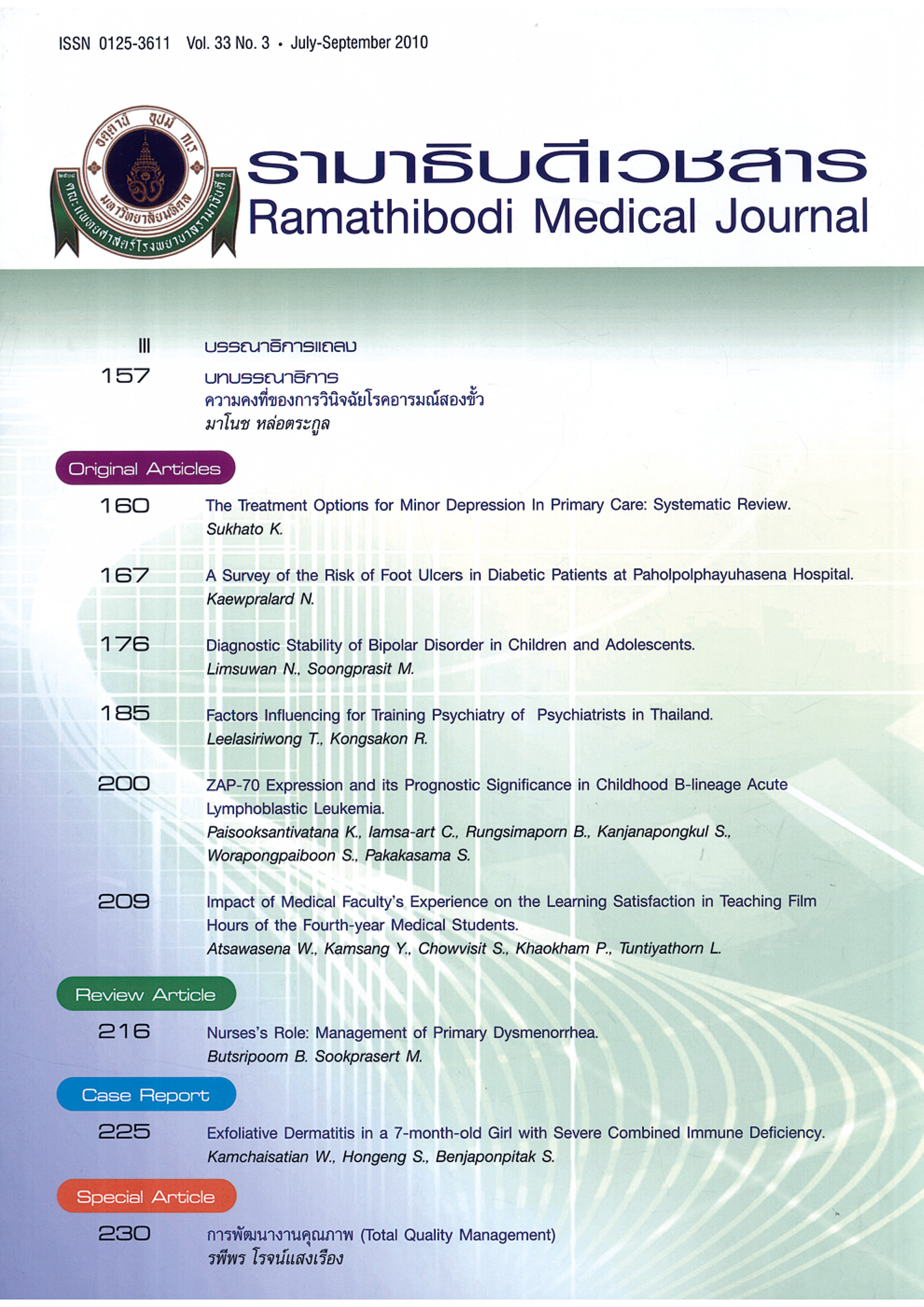Diagnostic Stability of Bipolar Disorder in Children and Adolescents
Keywords:
Bipolar disorder, Diagnostic stability, Children, AdolescentsAbstract
Objective: To examine diagnostic stability of bipolar disorder in children and adolescents and to determine factors associated with diagnostic stability.
Method: This was a retrospective chart review of patients who were diagnosed bipolar disorder when they were below 19 years old. All subjects, both inpatients and outpatients, received psychiatric care at Ramathibodi hospital during January 1998 to May 2008.
Results: There were 49 subjects who received the diagnosis during 8 - 18 years of age (mean 15.26 years) and the follow-up time was 4.18 + 3.10 years (mean ± S.D.). After receiving the diagnosis of bipolar disorder, 36 from 49 subjects (73.47%) were finally diagnosed bipolar disorder, whereas 13 subjects' diagnosis (26.53%) were changed to other psychiatric disorders which the most frequent diagnosis were schizoaffective disorder. The media time to change diagnosis was 2.02 years. Factor associated with diagnostic stability was using DSM IV criteria for diagnosis.
Conclusions: Among children and adolescents, after receiving the diagnosis of bipolar disorder, approximately 30% of patients had diagnostic changes to other psychiatric disorders and factor associated with diagnostic stability was using DSM IV criteria for diagnosis.
References
Biederman J. Early-Onset Bipolar Disorders. In: Sadock BJ. Sadock VA, editors. Kaplan and Sadock's Comprehensive Textbook of Psychiatry 8th ed. Philadelphia, PA: Lippincott Williams & Wilkins; 2005: 3274-9.
National Institute of Mental Health research roundtable on prepubertal bipolar disorder. J Am Acad Child Adolesc Psychiatry. 2001;40(8):871-8. doi:10.1097/00004583-200108000-00007.
Pavuluri MN, Birmaher B, Naylor MW. Pediatric bipolar disorder: a review of the past 10 years. J Am Acad Child Adolesc Psychiatry. 2005;44(9):846-71. doi:10.1097/01.chi.0000170554.23422.c1.
Kessing LV. Diagnostic stability in bipolar disorder in clinical practise as according to ICD-10. J Affect Disord. 2005;85(3):293-9. doi:10.1016/j.jad.2004.11.001.
Chen YR, Swann AC, Johnson BA. Stability of diagnosis in bipolar disorder. J Nerv Ment Dis. 1998;186(1):17-23. doi:10.1097/00005053-199801000-00004.
Geller B, Zimerman B, Williams M, Bolhofner K, Craney JL, Delbello MP, et al. Six-month stability and outcome of a prepubertal and early adolescent bipolar disorder phenotype. J Child Adolesc Psychopharmacol. 2000;10(3):165-73. doi:10.1089/10445460050167278.
Geller B, Craney JL, Bolhofner K, DelBello MP, Williams M, Zimerman B. One-year recovery and relapse rates of children with a prepubertal and early adolescent bipolar disorder phenotype. Am J Psychiatry. 2001;158(2):303-5. doi:10.1176/appi.ajp.158.2.303.
Geller B, Craney JL, Bolhofner K, Nickelsburg MJ, Williams M, Zimerman B. Two-year prospective follow-up of children with a prepubertal and early adolescent bipolar disorder phenotype. Am J Psychiatry. 2002;159(6):927-33. doi:10.1176/appi.ajp.159.6.927.













